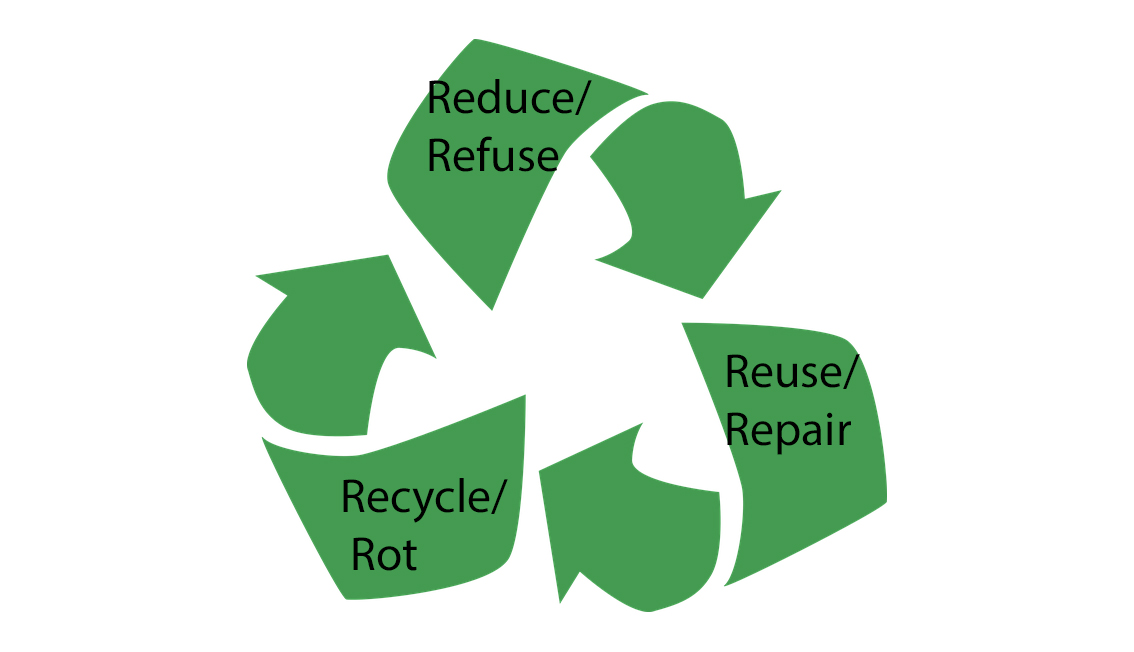There are several R’s associated with sustainability, often referred to as the “Three R’s” or “Five R’s.” These R’s represent different strategies or principles that promote sustainable practices and resource management. The most common R’s can be represented by the main 3 ‘Rr’s Reduce – Reuse – Recycle:
1. Reduce (or ‘Refuse’): This involves minimizing the consumption of resources, energy, and materials to decrease waste generation and environmental impact. It includes strategies such as using energy-efficient appliances, reducing water usage, and minimizing packaging. ‘Refuse’ e.g. refusing a plastic bag in a shop is another ’R’ that can be included under ‘Reduce’.
2. Reuse (incorporating ‘Repair’ and also, not an ’R’, but ‘Upcycling’ can be included here): Reusing products or materials instead of throwing them away helps conserve resources and reduces waste. Examples include using reusable bags, or repurposing materials for other purposes (this includes upcycling).
Repair is another ‘R’ that can be considered part of Reuse: Repairing broken or damaged items instead of replacing them can extend their lifespan and reduce the demand for new resources. Repairing items such as electronics, appliances, and furniture promotes a circular economy by keeping products in use for longer periods. Repairing clothes instead of throwing them away is also an important part of this principle.
3. Recycle (includes ‘Rot’): Recycling involves converting waste materials into new products or materials. It is an essential process for reducing the extraction of new resources and reducing the amount of waste sent to landfills. Recycling often involves sorting materials like paper, plastic, glass, and metal that are then processed to create new products.
Rot (Compost) is sometimes listed as a separate ‘R’ but can be considered as another form of ‘Recycle’, and is the ultimate way that nature operates, efficiently recycling everything. Composting is the process of decomposing organic waste, such as food scraps and garden trimmings, to create nutrient-rich soil called compost and It helps divert organic waste from landfills, reduces greenhouse gas emissions, and provides a natural fertilizer for gardens and agricultural activities.
These R’s serve as guiding principles for individuals, businesses, and communities to adopt more sustainable practices and reduce their environmental impact. Notice that ‘Recycle’ is last in the list, with reduce and reuse being preferable to creating waste at all.
Why should you use reusable bags for produce? Here are some benefits:
- Environmental Impact: Natural fibre bags, such as cotton or jute, have a lower environmental impact compared to synthetic materials like plastic or nylon. Synthetic materials take a long time to break down and contribute to plastic pollution, whereas natural fibres are biodegradable and have a lower carbon footprint.
- Resource Conservation: Using natural fibre bags promotes the conservation of resources. Synthetic materials like plastic require the extraction of fossil fuels, contributing to resource depletion and environmental degradation. On the other hand, natural fibres can be sustainably sourced and grown, reducing the strain on natural resources.
- Recycling Potential: Natural fibre bags can be recycled when they wear out or are no longer usable. Recycling natural fibres helps reduce waste and minimizes the need for additional resource extraction. In contrast, many synthetic bags cannot be easily recycled, leading to increased waste accumulation.
- Biodegradability: Natural fibre bags are biodegradable, meaning they break down into organic materials over time. This characteristic reduces the long-term environmental impact and prevents the accumulation of non-biodegradable waste. Synthetic bags, especially those made from plastic, persist in the environment for hundreds of years and contribute to pollution.
- Consumer Safety: Natural fibre bags are generally considered safer for consumers, especially when used for carrying food items like loose produce. Synthetic bags may contain harmful chemicals or toxins that can leach into food, potentially posing health risks. Natural fibres are generally non-toxic and do not pose the same concerns.
- Support for Sustainable Practices: By choosing natural fibre bags, you are supporting sustainable practices and responsible consumption. Opting for reusable and recyclable materials aligns with the principles of reducing waste, conserving resources, and promoting environmentally friendly choices.
- Aesthetics and Appeal: Natural fibre bags often have an aesthetic appeal, providing a more visually pleasing alternative to synthetic bags. The natural texture and appearance of materials like cotton or jute can enhance the shopping experience and make it more enjoyable.
- Overall, using natural fibre bags for loose produce shopping combines environmental benefits, resource conservation, recycling potential, consumer safety, and support for sustainable practices.
